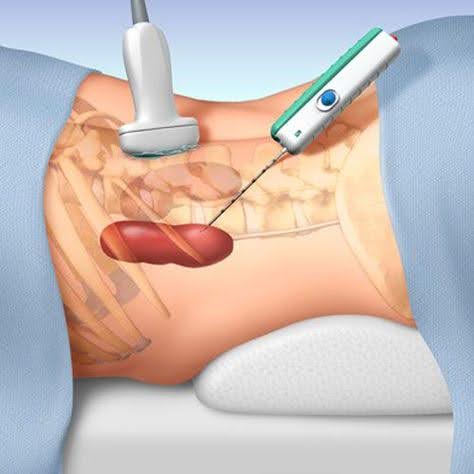The Role of Kidney Biopsies in Diagnosis and Treatment Planning
10/09/2025
When routine blood tests and imaging aren’t enough to explain your kidney problems, a biopsy may offer the answers you need.
Imagine your kidneys, two small yet powerful organs, working silently around the clock to filter your blood and maintain your body’s balance. But what happens when something goes wrong? Kidney disease often develops with no obvious symptoms, and standard lab results or urine tests can’t always reveal what’s causing your kidney problem. That’s where a kidney biopsy becomes a vital tool.
According to the National Institute of Diabetes and Digestive and Kidney Diseases (NIDDK), chronic kidney disease (CKD) affects over 35 million [NR1] [NR2] adults in the U.S., many of whom are unaware of their condition. In a subgroup of patients with CKD, a kidney biopsy may be the only way to diagnose certain types of kidney diseases and create an effective treatment plan.
What is a Kidney Biopsy?
A kidney biopsy is a procedure where a doctor removes a small tissue sample from your kidney. This sample is examined under a microscope to check for signs of damage or disease. The goal? To get to the root of the problem, so your care team can make precise treatment decisions.
Roughly 10–15 % of patients with CKD overall could potentially benefit from a diagnostic biopsy (excluding transplant or acute kidney injury (AKI) indications).
That fraction rises to 20–35 % among patients with:
- Rapidly progressive CKD (rise in creatinine >30 % in months)
- Proteinuria > 1 g/day or nephrotic syndrome
- Active urine sediment (dysmorphic RBCs, casts)
- Unexplained CKD in non-diabetic, non-hypertensive individuals
- Suspected systemic disease (lupus, ANCA vasculitis, amyloidosis, monoclonal gammopathy)[NR1] [MK2]
When Biopsy Usually Does Not Help
- Advanced irreversible CKD (small echogenic kidneys; glomerular filtration rate (eGFR) < 15–20) — tissue yield is low; management unaffected.
- Classic diabetic nephropathy (longstanding diabetes, retinopathy, no active sediment).
- Ischemic or hypertensive nephrosclerosis with typical clinical picture.
- High bleeding risk or solitary kidney — risk > benefit.

There are two main types of kidney biopsies:
- Percutaneous kidney biopsy: The most common. A needle is inserted through your skin and into your kidney, often with ultrasound or CT imaging to guide the needle.
- Open biopsy: Performed surgically, often if the patient is already undergoing another operation or if a percutaneous method isn’t possible.
The biopsy procedure is usually done on an outpatient basis and takes around 30–60 minutes.
Common Kidney Diseases Diagnosed by Biopsy
| Condition | Key Biopsy Findings | Treatment Implications |
| FSGS (Focal Segmental Glomerulosclerosis) | Segmental scarring of glomeruli | Immunosuppressants, ACE inhibitors |
| Minimal Change Disease | Podocyte effacement, no visible scarring | Steroids |
| Lupus Nephritis | Immune complex deposits, inflammation | Steroids + immunosuppressants |
| IgA Nephropathy | IgA deposits in mesangium | Blood pressure control, immunosuppressants (severe) |
| Acute Tubular Necrosis (ATN) | Tubular cell damage | Supportive care, avoid nephrotoxic drugs |
| Kidney Transplant Rejection | Inflammatory cells, arteritis, tubulitis | Adjust immunosuppressants |
Risks and Considerations
While kidney biopsies are done safely in most patients, there are some risks of a kidney biopsy to be aware of:
- Bleeding is the most common risk. You may see blood in your urine for a few days after the procedure.
- You may feel pain at the biopsy site, which can be managed with over-the-counter pain relievers.
- Rare complications include injury to a blood vessel, infection, or the need for a second procedure if not enough tissue is obtained.
It’s also a good idea to check your insurance coverage before the biopsy. Visit our insurance information page to learn more about what’s covered and how to prepare for costs related to your biopsy and treatment.
Conditions That May Increase the Risk of Bleeding:
- A history of bleeding disorders
- Use of blood thinners or NSAIDs
- High blood pressure not well-controlled
Before the procedure is done, your doctor may ask you to stop certain medications and will perform blood tests to check your clotting ability. You’ll receive local anesthesia to numb the area, and you may be asked to hold your breath briefly during the procedure.
Innovations and Future Trends
Recent advances are making kidney biopsies safer and more accurate:
- Image-guided biopsies using real-time ultrasound or CT improve needle precision
- Research is exploring liquid biopsies using urine or blood samples, which could someday replace needle biopsies
- AI-driven pathology tools are helping pathologists interpret results faster and with higher accuracy
- Molecular and genetic analysis of kidney tissue is improving our understanding of rare or complex kidney conditions
What to Expect Before and After the Biopsy
Understanding how to prepare for your kidney biopsy, and what to expect afterward, can ease anxiety and promote a smoother recovery. Here’s a detailed guide to help you feel more confident about the process.
Before the Procedure
In the days leading up to your biopsy, your doctor will provide instructions tailored to your specific health status. Common preparation steps include:
- Arrange Transportation: Because sedation or local anesthesia is used, and you’ll need to rest afterward, it’s important to have someone drive you home.
- Review Medications: Inform your doctor about all medications and supplements you take, especially blood thinners (like aspirin, warfarin, or NSAIDs), as these may increase the risk of bleeding. You may need to stop them temporarily.
- Fasting: You’ll likely be asked to avoid food and drink for 6–8 hours before the biopsy, especially if sedation or anesthesia will be used.
- Dress Comfortably: Wear loose, easy-to-remove clothing for the procedure.
- Consent Form: You’ll be asked to sign a consent form, acknowledging that you understand the procedure, its purpose, and its risks.
Your care team will also conduct blood tests to ensure your blood clots normally and check your blood pressure, as uncontrolled hypertension can increase the risk of bleeding.
After the Procedure
Recovery usually takes place in a medical setting for several hours after the biopsy:
- Observation Period: You’ll lie on your back and be closely monitored for signs of bleeding or complications. Nurses will regularly check your blood pressure and examine your urine for signs of blood.
- Physical Restrictions: Avoid heavy lifting, bending, or strenuous activity for at least 48 hours, as these can increase pressure on the kidney and trigger bleeding.
- Pain Management: Mild soreness or dull pain at the biopsy site is common. Over-the-counter pain medications like acetaminophen (Tylenol) are usually sufficient. Avoid NSAIDs unless cleared by your doctor.
- Hydration: Drinking plenty of fluids will help flush any blood from your urinary tract and support kidney recovery.
Most people can return home the same day and resume normal activities within a few days, depending on how they feel.
Potential Questions to Ask Your Doctor About Kidney Biopsy
- What are we hoping to learn from this biopsy?
- Are there alternatives to biopsy in my case?
- How will the results change my treatment plan?
Getting Clear Answers for Better Kidney Care
A kidney biopsy can also uncover critical answers when other tests leave doctors guessing. Whether you’re dealing with a transplanted kidney, unexplained symptoms, or complex disease, a small kidney sample can make a big difference.
If your doctor says you may need a kidney biopsy, don’t panic. The procedure is generally safe and often life-saving. It’s one of the best tools to diagnose kidney problems accurately and guide effective treatment.
Talk to your nephrologist today about whether a biopsy could help clarify what’s causing your kidney problem, and how best to treat it.
If you’re looking for a nearby kidney care provider or dialysis center, use our location finder page to find a clinic close to you.
Frequently Asked Questions
A kidney biopsy is performed to examine kidney tissue under a microscope. It helps diagnose the cause of kidney disease, assess severity, guide treatment, and monitor response to therapy.
Kidney biopsies rarely detect cancer, with studies showing only about 1–5% of biopsies revealing malignancy. Most biopsies are performed to diagnose non-cancerous kidney diseases.
Further Reading:
- National Kidney Foundation (NKF)
- National Institute of Diabetes and Digestive and Kidney Diseases (NIDDK)
- Mayo Clinic Kidney Biopsy Info
- American Society of Nephrology (ASN)

Dr. Allen Kaufman is the Chief Medical Officer and Senior VP for Clinical & Scientific Affairs at Dialyze Direct, with over four decades of experience in Nephrology. He began his career in 1980 and has held leadership roles including Chief of Nephrology & Hypertension at Beth Israel Medical Center (1998–2004), Chief of Dialysis at the Bronx VA Medical Center (1982–1990), and Chief of the Yorkville Dialysis Unit at Beth Israel and the Renal Research Institute (1990–2000). Dr. Kaufman has authored over 100 scientific publications and served as Principal or Co-Investigator on numerous NIH-funded research studies. A Fellow of the American College of Physicians, he is board-certified in Nephrology and Internal Medicine. He earned his medical degree from the University of Rochester and completed training at the Hospital of the University of Pennsylvania and Mount Sinai in New York. Dr. Kaufman is widely recognized with multiple “Best Doctor” and “Patients’ Choice” awards.